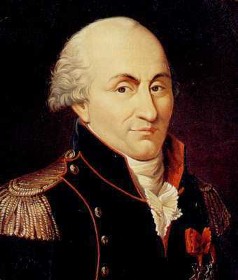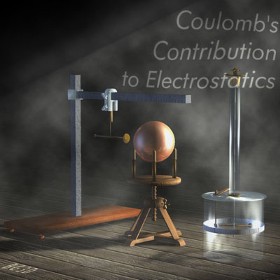Charles Augustin de Coulomb (1736 - 1806)
 Charles Augustin Coulomb was born in 14 June 1736 of Henry Coulomb and Catherine
Bajet. Both parents came from families which were well known in their fields.
His father's family was important in the legal profession and in the administration
of the Languedoc region of France, and his mother's family was also quite
wealthy. After being brought up in Angoulême, the capital of Angoumois in southwestern
France, Coulomb's family moved to Paris. In Paris he entered the Collège
Mazarin, where he received a good classical education.
Charles Augustin Coulomb was born in 14 June 1736 of Henry Coulomb and Catherine
Bajet. Both parents came from families which were well known in their fields.
His father's family was important in the legal profession and in the administration
of the Languedoc region of France, and his mother's family was also quite
wealthy. After being brought up in Angoulême, the capital of Angoumois in southwestern
France, Coulomb's family moved to Paris. In Paris he entered the Collège
Mazarin, where he received a good classical education.
Coulomb graduated in November 1761from Ecole du Génie at Mézières. Over the next twenty years he was posted to a variety of locations where he was involved in engineering, in structural , fortifications, soil mechanics, as well as other fields of engineering. His first posting was to Brest but in February 1764 he was sent to Martinique, in the West Indies, where he was put in charge of building the new Fort Bourbon and this task occupied him until June 1772.
On his return to France, Coulomb was sent to Bouchain. However, he now began to write important works on applied mechanics and he presented his first work to the Académie des Sciences in Paris in 1773. In 1779 Coulomb was sent to Rochefort to collaborate with the Marquis de Montalembert in constructing a fort made entirely from wood near Ile d'Aix. During his period at Rochefort, Coulomb carried on his research into mechanics, in particular using the shipyards in Rochefort as laboratories for his experiments.
Coulomb and corrosion monitoring

His studies into friction in Rochefort led to Coulomb's major work on friction Théorie des machines simples which won him the Grand Prix from the Académie des Sciences in 1781. This 1781 memoir basically changed Coulomb's life. He was elected to the mechanics section of the Académie des Sciences as a result of this work, and he moved to Paris where he now held a permanent post. He never again took on any engineering projects, although he did remain as a consultant on engineering matters, and he devoted his life from this point on to physics rather than engineering. He wrote seven important treatises on electricity and magnetism which he submitted to the Académie des Sciences between 1785 and 1791.
When the French Revolution began in 1789Coulomb had been deeply involved with his scientific work. Many institutions were reorganised, not all to Coulomb's liking, and he retired from the Corps du Génie in 1791. At about the same time that the Académie des Sciences was abolished in August 1783, he was removed from his role in charge of the water supply and, in December 1793, the weights and measures committee on which he was serving was also disbanded. (reference)
The Académie des Sciences was replaced by the Institut de France and Coulomb returned to Paris when he was elected to the Institute in December 1795. On 30 July 1797 his second son was born and, in 1802, he married Louise Françoise LeProust Desormeaux, the mother of his two sons. Between 1802 and 1806Coulomb was inspector general of public instruction and, in that role, he was mainly responsible for education in lycées across France.

Connect with us
Contact us today